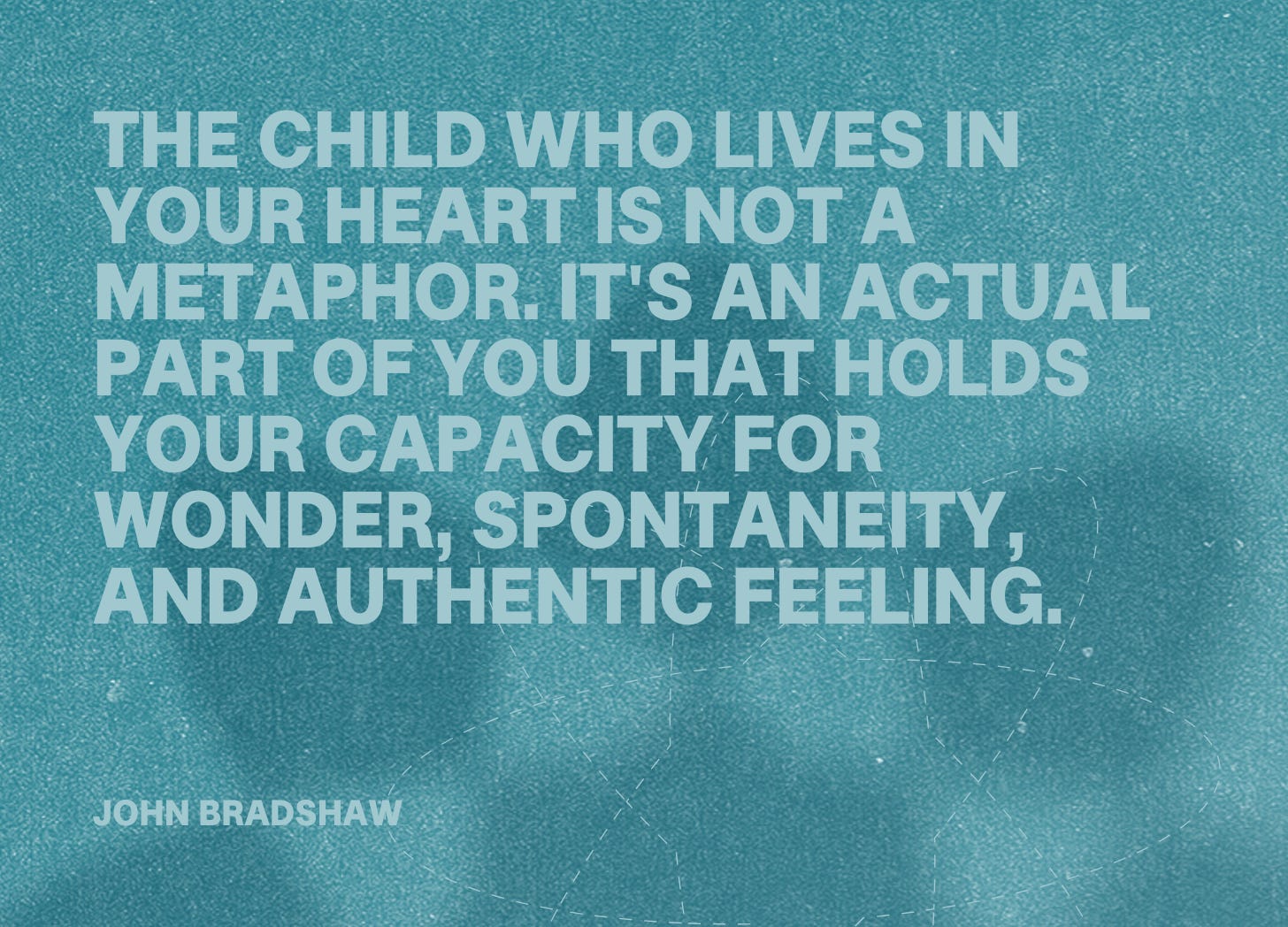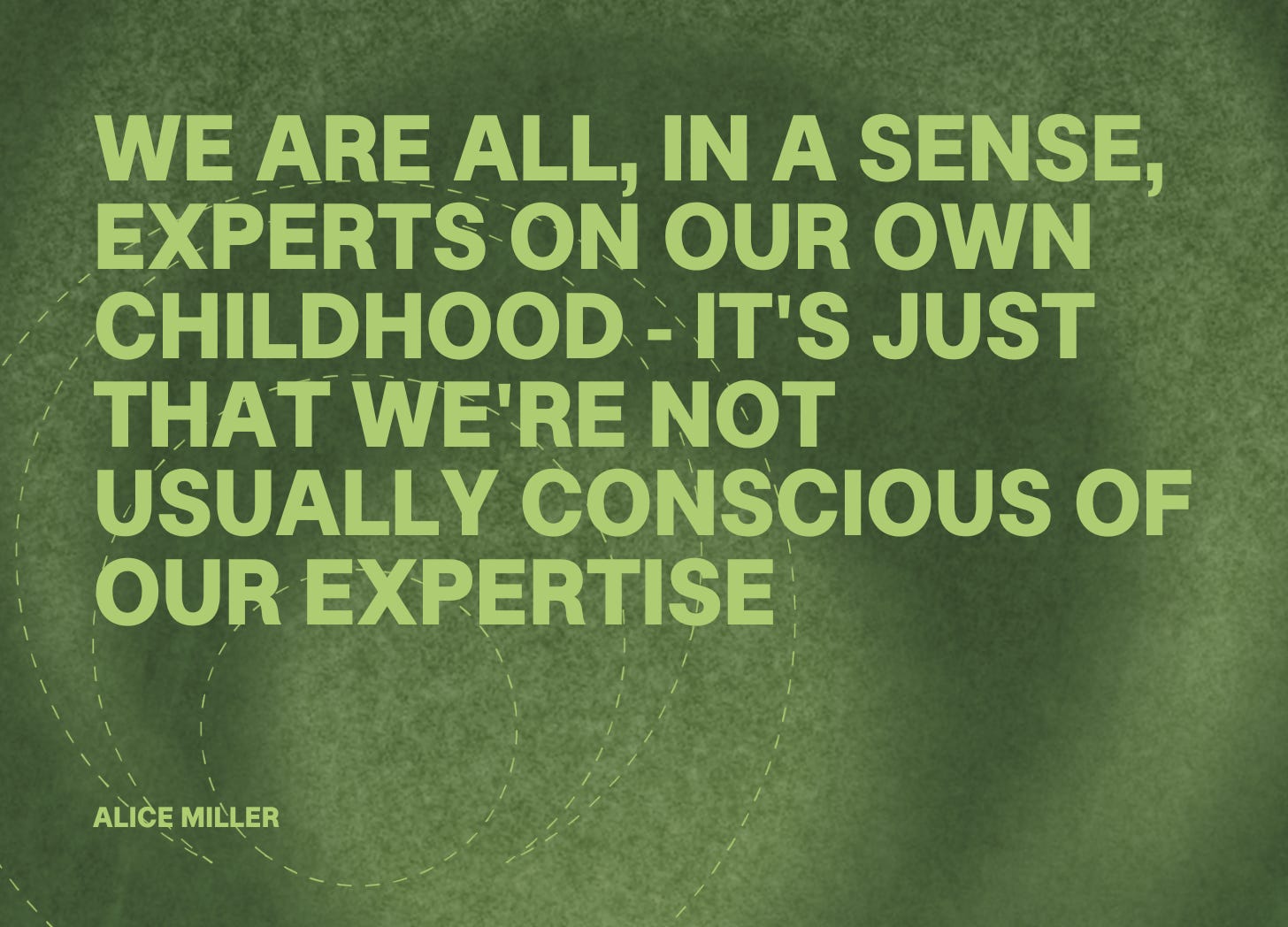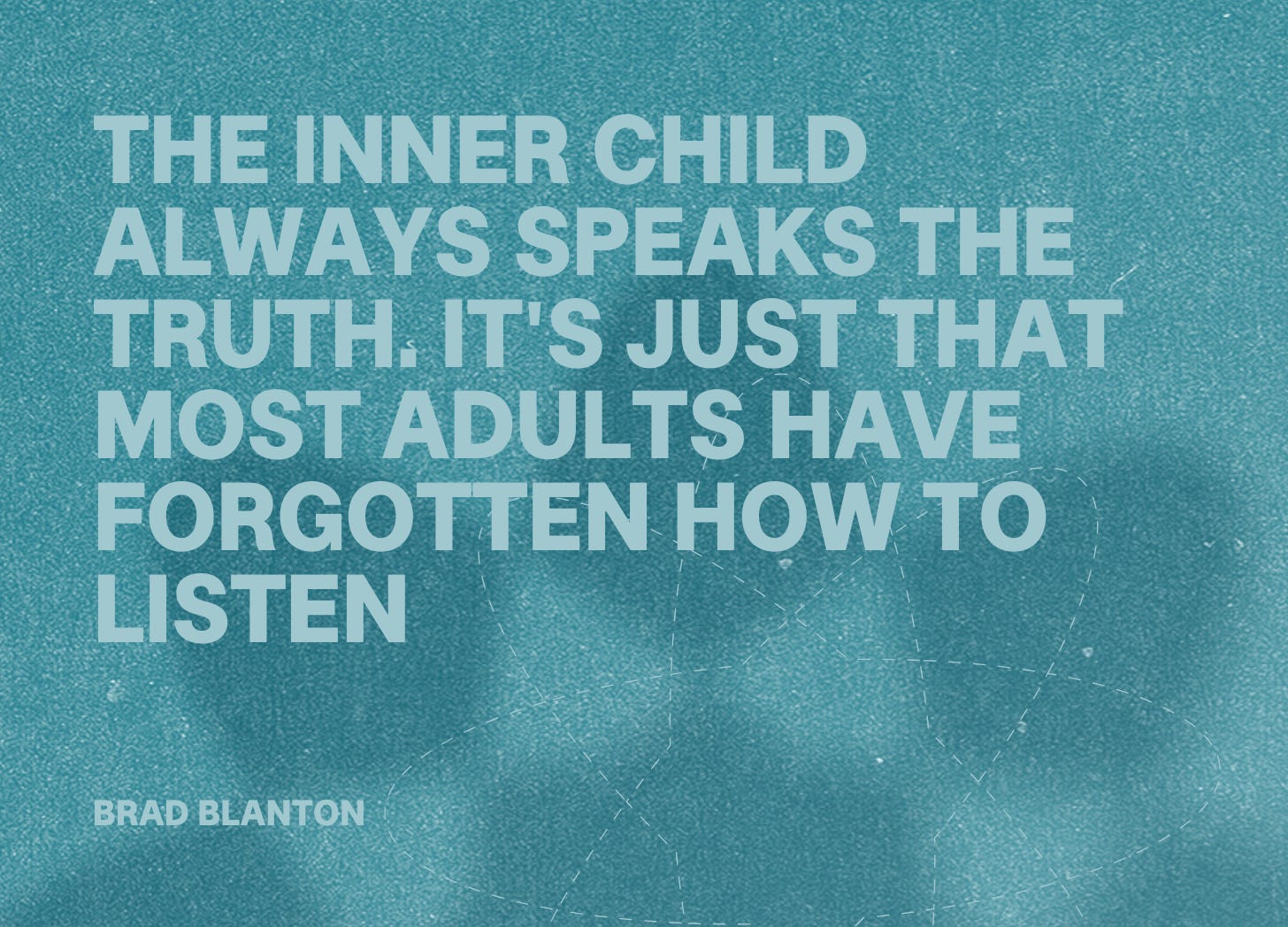Meeting your inner child
Introduction to Shadow Work - Part 6
Thanks for being here. This is the sixth lesson in your free Introduction to Shadow Work course. If you have landed here without reading the previous lessons, I recommend you start from the beginning. Subscribe below, and I’ll send you links to all the lessons in the course.
In the last lesson, we discussed how you are not just one unified self but a family of internal parts. Today, we will meet one of your most important parts: your inner child.
Now, before you roll your eyes and think "here comes the woo-woo stuff," stay with me. Your inner child isn't some abstract concept - it's the very real part of you that still carries the feelings, needs, and experiences of your younger self.
Let me tell you about three people who learned to work with their inner child:
Rachel is 38 and incredibly successful. She's a partner at a law firm, owns a beautiful home, and seems to have it all together. But inside, she feels constantly anxious and never good enough. In therapy, she realised there's a seven-year-old part of her that's still trying to earn her critical father's approval. This young part drives her perfectionism and workaholism, always trying to prove she's worthy of love. When Rachel learned to talk to this part directly - to reassure her and give her the approval she never got - her anxiety began to ease.
Tom is 43 and has been married three times. Every relationship follows the same pattern: he falls hard, becomes clingy and demanding, then pushes his partner away with jealousy and accusations. When he started looking at this pattern through a parts lens, he discovered an eight-year-old part who was devastated when his parents divorced. This part is terrified of abandonment and tries to control his partners to prevent them from leaving. When Tom learned to comfort this young part instead of letting it run his relationships, he was able to start changing his patterns.
Alison is 29 and struggles with creativity blocks. She's an artist but can barely finish any projects. She starts with enthusiasm, then abandons everything halfway through. In exploring her inner child, she found a twelve-year-old part who was shamed for being "too dramatic" and "not practical enough." This part learned to shut down creatively to avoid criticism. When Maya started encouraging this young part and creating safe spaces for her to play, her creativity exploded.y
What is your inner child?
Your inner child is the part of you that holds your early experiences, emotions, and needs. It's not just one part - you might have a toddler part that needs comfort, a five-year-old part that wants to play, a ten-year-old part that craves adventure, and a teenage part that longs for acceptance.
These parts don't age with your body. They remain frozen at the developmental stage where they experienced significant events.
Your inner child carries:
Your earliest wounds and traumas
Your unmet needs from childhood
Your natural spontaneity and joy
Your capacity for wonder and creativity
Your authentic feelings before you learned to hide them
Your dreams and desires before the world told you they were unrealistic
How your inner child shows up in adult life
Your inner child is already influencing your life - you're unaware of it. Here's how different inner child parts might be showing up:
The Abandoned Child: Feels desperate for love and attention. Might cause you to be clingy in relationships, seek validation constantly, or panic when people are unavailable.
The Wounded Child: Carries pain and trauma. Might cause you to shut down emotionally, expect rejection, or feel fundamentally flawed.
The Angry Child: Holds rage about unfairness and hurt. Might cause you to have explosive outbursts, hold grudges, or use passive aggression.
The Fearful Child: Learned the world isn't safe. Might cause you to avoid risks, stay in your comfort zone, or develop anxiety disorders.
The Performing Child: Learned love was conditional on being good. Might cause you to be a perfectionist, people pleaser, or high achiever who never feels good enough.
The Free Child: Your natural, joyful essence. Might show up when you're laughing, playing, being creative, or feeling wonder.
Your inner child is the part of you that knows how to love unconditionally, play freely, and feel deeply.
Why inner child work matters
When your inner child parts are wounded and unhealed, they unconsciously drive your adult behaviour:
The part that was abandoned keeps choosing unavailable partners
The part that was criticised becomes a perfectionist who's never satisfied
The part that felt unsafe becomes anxious and controlling
The part that was ignored becomes desperate for attention
The part that was shamed goes into hiding and sabotages success
When you do the work to heal and reparent your inner child, you unlock your:
Spontaneity and playfulness
Emotional authenticity and depth
Creativity and imagination
Capacity for joy and wonder
Ability to trust and be vulnerable
Connection to your true desires and dreams
How to Connect with Your Inner Child
1. Notice when your inner child is activated
Pay attention to when you feel younger than your chronological age. When do you feel small, scared, or overwhelmed? When do you react in ways that seem disproportionate? When do you feel criticised, abandoned, or not good enough?
These are moments when an inner child part is triggered.
2. Get curious about the age
When you notice a young part activated, ask: "How old does this part feel?" Often, you'll get a sense of a specific age - maybe 5, or 8, or 13. This gives you information about when this part got stuck.
3. Speak to your inner child directly
This might initially feel strange, but try having an internal conversation with this young part. You can do this in your mind, journaling, or even aloud.
Ask things like:
"What do you need right now?"
"What are you afraid of?"
"How can I help you feel safe?"
"What do you want me to know?"
4. Give your inner child what It needed
This doesn't mean becoming childish or irresponsible. It means giving your inner child the understanding, comfort, and reassurance it never got.
If it's scared, reassure it that you're safe now
If it's sad, comfort it and let it cry
If it's angry, validate its feelings and protect its boundaries
If it's lonely, spend time with it and show it love
If it's creative, give it space to play and express
Your inner child practice this week
Here's a gentle way to start building a relationship with your inner child:
Daily Check-In: Each morning, ask your inner child: "How are you feeling today? What do you need?" Listen for the first thing that comes to mind.
The Inner Child Letter: Write a letter from your adult self to your child self. Tell this young part:
That you're sorry for any pain they experienced
That they are loved and worthy just as they are
That you're here now to take care of them
What you want them to know about their strength and beauty
Reparenting Moments: When you notice your inner child activated during the day, pause and ask: "What would a loving parent say to this child right now?" Then say those words to yourself.
You are never too old to have a happy childhood through healing your inner child.
Important Reminders
Go slowly: Your inner child has been protecting itself for years. It will be very happy to be acknowledged finally, but don't expect instant results. Build the relationship gradually.
You're not becoming childish: Healing your inner child doesn't mean becoming immature. It means integrating your natural spontaneity and emotional truth with your adult wisdom.
Professional support: If connecting with your inner child brings up intense trauma or overwhelming emotions, please seek professional help. This work is best done with proper support.
It's not about blame: This work isn't about blaming your parents or caregivers. It's about healing the parts of you that got hurt and giving them what they need now.
What your inner child wants you to know
If your inner child could speak to you right now, here's what it might say:
"I've been waiting for you to turn toward me with love instead of judgment. I'm not trying to ruin your life - I'm trying to get your attention. I have gifts for you - your capacity for joy, wonder, creativity, and authentic feeling. But I also have pain that needs your compassion. Please don't abandon me anymore. Please don't try to fix me or make me grow up. Just love me. Just be with me. That's all I've ever wanted."
In the next lesson, we will explore one of the most misunderstood emotions: sadness and grief. We'll look at how the parts of you that carry unprocessed loss might be affecting your life, and how learning to sit with sadness can actually be a pathway to deeper joy and aliveness.
Your inner child is a gift waiting to be reclaimed.
Stay playful.
P.S. If you felt emotional reading this email, that might be your inner child responding. Notice what comes up. Maybe it's relief at finally being seen, sadness at years of being ignored, or fear of vulnerability. All of these responses are welcome and valid.
Remember: This work involves building a loving relationship with all parts of yourself, including the young, tender ones that need your care.






The hardest hitting chapter I’ve read yet. I’ll have to come back and read it again. I plan to do a journal entry around this inner child. I’m aware that this is the darkest area of my shadow, the inner child.